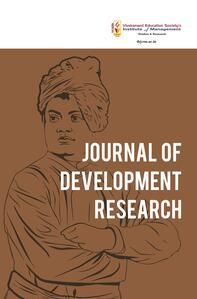
1 Rajarambapu Institute of Technology, Department of Management Studies (MBA), Affiliated to Shivaji University, Kolhapur, Maharashtra, India
Creative Commons Non Commercial CC BY-NC: This article is distributed under the terms of the Creative Commons Attribution-NonCommercial 4.0 License (http://www.creativecommons.org/licenses/by-nc/4.0/) which permits non-Commercial use, reproduction and distribution of the work without further permission provided the original work is attributed.
The foundation of every nation’s economic structure is made up of financial institutions. It consists financial institutions such as banks, credit societies, asset management companies, insurance firms and mortgage lenders. They assist the economy expand by giving their clients financial support and services. One of the key factors in the growth of the national economy is seen as being banks. The current study examines the financial results of the nation’s public and private sector banks in order to comprehend how well the bank makes financial decisions. Moreover, to identify the various factors that affect the bank’s financial stability. The research instrument used is capital adequacy, asset quality, management capability, earnings capacity and liquidity model and t-test. It can be concluded that public sector banks need to focus on strategic decisions for sustaining in the competition with private sector banks. They require to be more professional as like private players in the banking business.
Adequacy, capital, efficiency, financial, performance management, quality
Angela, R., & Alina, C. S. (2013). Analyzing the financial soundness of the commercial banks in Romania: An approach based on the CAMELS framework. Procedia Economics and Finance, 6(2013), 703–712. https://doi.org/10.1016/S2212-5671(13)00192-5
Baral, K. J. (2005). Health check-up of commercial banks in the framework of CAMEL: A case study of joint venture banks in Nepal. The Journal of Nepalese Business Studies, 2(1), 41–55. https://doi.org/10.3126/jnbs.v2i1.55
Dincer, H., Gulsah, G., Nazife, O., & Kevser, S. (2011). A performance evaluation of the Turkish banking sector. Procedia Social and Behavioral Sciences, 24,1530–1545. https://doi.org/10.1016/j.sbspro.2011.09.051
Dzeawuni, W. A., & Tanko, M. (2008). CAMELs and banks performance evaluation: The way forward. SSRN, 1–21. https://dx.doi.org/10.2139/ssrn.1150968
Echekoba, F. E., Egbunike, C. F., & Ezu, G. K. (2014). Determinants of bank profitability in Nigeria: Using CAMEL rating model. IOSR Journal of Business and Management, 16(9), 44–50.
Golam, M. (2014). Use of CAMEL model: A study on financial performance of selected commercial banks in Bangladesh. Universal Journal of Accounting and Finance, 2(5), 151–161. https://doi.org/10.13189/ujaf.2014.020504
Jaspreet, K., Manpreet, K., & Simranjit, S. (2015). Financial performance analysis of selected public sector banks: A CAMEL model approach. IJABER, 13(6), 4327–4348. https://www.researchgate.net/publication/301681152
Mihir, D., & Annyesha, D. (2009). A CAMELs analysis of the Indian banking industry. SSRN, 1–10. http://dx.doi.org/10.2139/ssrn.1666900
Mishra, A. K., Harsha, G. S., Shivi, A., & Neil, R. D. (2012). Analyzing soundness in Indian banking: A CAMEL approach. Research Journal of Management Sciences, 1(3), 9–14. http://isca.in/IJMS/Archive/v1/i3/2.ISCA-RJMS-2012-028.pdf
Mishra, S. K., & Aspal, P. K. (2012). A CAMEL model analysis of state bank group. Proceedings of 19th International Business Research Conference 2012. https://ssrn.com/abstract=2177099
Muhammet, M., Arnold, R., Reha, Y., & Ahmet, B. E. (2003). The effect of scale and mode of ownership on the financial performance of the Turkish banking sector: Results of a DEA-based analysis. Socio-economic Planning Sciences, 37(2003), 185–202.
Rehana, K., & Irum, S. (2012). Gauging the financial performance of banking sector using CAMEL model: Comparison of conventional, mixed and pure Islamic banks in Pakistan. International Research Journal of Finance and Economics, 82(2012), 68–88.
Sangmi, M. & Nazir, T. (2010). Analyzing financial performance of commercial banks in India: Application of CAMEL model. Pakistan Journal of Commerce and Social Sciences, 4(1), 40–55. https://www.econstor.eu/handle/10419/187999
Siti, N. M., & Hafiza, A. H. (2015). Using the CAMEL framework in assessing bank performance in Malaysia. International Journal of Economics, Management and Accounting, 23(1), 109–127. https://www.researchgate.net/publication/279200285